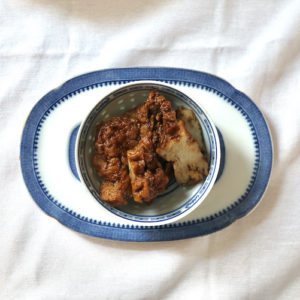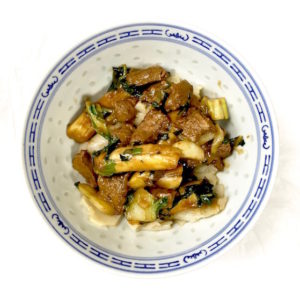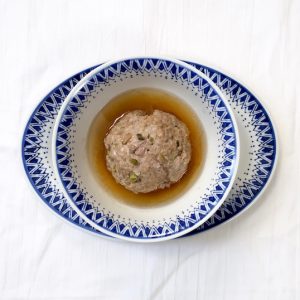Stir-fried bok-choy with seitan/stir-fried Chinese pickles with seitan
As promised, recipes incorporating seitan. The first, bok-choy with seitan, calls for widely available ingredients. The second recipe calls for Chinese pickled vegetable, which I’ve never seen sold outside an Asian market. I am fortunate to live near Asian megamarket 99Ranch. Others may not be so lucky.

I posted these recipes on Instagram last week to a decidedly mixed response. While many people were enthusiastic, others associated with seitan with grim vegetarian meals involving nut roasts and the dread tofurkey. If you feel the same, by all means substitute the seitan for another protein–chicken, pork, tofu–or take the plant-only route.

I had never seen ginger on the stalk before. The young farmer selling it to me was stunned by this. “I’m from Detroit,” I tried explaining. The Detroit of my childhood was not a place where ginger grew. It was a place that grew cars. Or tried to. There were problems with this, which is why I write to you from the economically bustling San Francisco Bay Area, where a person may buy ginger, but not a place to live.
I digress.

Before we start cooking, a few (limited) words of explanation concerning Chinese pickles. Limited because I am no expert. What I do know is the Chinese people pickle, sun-dry, brine, and salt various types of mustard and radish. The pickles are then packed in foil pouches or clay jars and shipped to Asian markets. As the English on the packaging is often limited, I suggest buying a few and sampling them to see which you like best.

Most of these pickles are rinsed before using. Place the intended amount in a colander, rinse under running water, and pat or squeeze dry. Any leftover pickle keeps well in the refrigerator.

Chinese pickled vegetable is delicious in stir-fries, soups, or as a condiment alongside rice. It tastes a bit like hamburger pickle relish, but punchier.

Yes, a ruler was necessary.
On a recent trip to 99Ranch, my favorite pickle was out stock. The pickles live at the end of the dried fish aisle, in an open chiller cabinet. They’re always a rather haphazard pile of various brands, all tumbled together; as the store itself is always clean and tidy, one is led to suspect the customers mess them up. I don’t know. Anyway, I spent a few minutes rummaging (i.e., further messing up the pile) hoping to unearth a lone package at the bottom. Alas, no. Instead, I noticed this bright red packet–which I’d never seen before- reading “Spicy Flavour Mustard Tuber.” Regular readers will be shocked to know I bought it.

That very evening I opened the bag for a small taste. Suffice to say I returned to the Ranch a few days later, and laid in a supply.

Top: Non-spicy Chinese vegetable pickle. Bottom: spicy mustard tuber, unrinsed, to ensure all that spicy goodness stays put.
Both of these recipes assume you have seitan ready-cooked. I had 6 ounces/180g left from last batch I made, which I divided into portions of 3 ounces/90 g each. This may sound quite scant, but served with other dishes and rice it’s ample for two modest eaters.

These dishes are just ideas for ways to use seitan; you can subsitute all the meat in these dishes, or use less meat and add a bit of seitan (or tofu). The goal here is to eat well while reducing the stress on the planet. It is not to hector anyone, or to be sanctimonious about diet, because that never helps. Besides, it’s hardly my business what you eat.

The dish above is half stir-fried Chinese pickles with chicken, and half with seitan. I served it to my husband, as I was unsure if he’d like the seitan. He did.

Above, stir-fried seitan with Chinese pickle and Korean rice stick. Below, stir-fried bok-choy with seitan and white rice.

Stir-Fried Bok Choy with Seitan
Yield: serves 2-3 as part of an Asian style meal; easily scaled upward.
Prep time: 15 minutes; this is cutting vegetables and stir-frying. To make seitan, click here, or consult Mark Bittman’s excellent recipe in How To Cook Everything Vegetarian.
This recipe owes a great deal to a bok-choy stir-fry in Grace Young’s The Wisdom of The Chinese Kitchen
approximately 3 ounces/90 grams seitan
1 teaspoon cornstarch
roughly 12 ounces/350 grams bok choy or other Chinese leafy greens
1 thick slice ginger, about 1-in/4 cm across
2 garlic cloves, peeled and minced
1 scallion, trimmed and thinly sliced
1 tablespoon oyster sauce
2 tablespoons water
1 1/2 teaspoons regular soy sauce
two tablespoons rice wine or dry sherry, plus more for cooking, if needed
peanut or grapeseed oil, for stir-frying
You will need a wok or large frying pan to make this recipe. Serve with rice or rice noodles. I used a 14-inch (35 cm) wok. You will also need a few small bowls.
Slice the seitan into pieces small enough to be eaten with chopsticks or, in our case, forks, as we’re too clumsy to manage chopsticks. Don’t worry about slicing each piece of seitan perfectly evenly. Place the pieces in smallish bowl. Mix with the cornstarch.
Wash and trim the bok choy, then slice as for the seitan.
Mince the garlic, ginger, and scallion, and place them in a small dish or bowl.
In another small bowl, mix the oyster sauce, water, soy sauce, and rice wine, stirring with a fork to blend.
Place the wok or frying pan over high heat and allow to heat up. Add the peanut oil and turn heat down slightly. Tip in the garlic, ginger, and scallion, stir-frying for 30 seconds. If the wok seems too hot–sputtering and spitting madly instead of cooking–turn heat down a bit. If all is well, add the oyster sauce mixture, stirring constantly, then add the vegetables, letting them soften, stirring all the while. Add rice sticks, if using. Add more rice wine if wok seems dry. Now add the seitan, stirring to blend with bok choy. Cook for two to three minutes, until everything is cooked through and steaming hot.
Turn bok choy out on to platter or into a bowl. Serve immediately if possible. If not, place in low oven 20-30 minutes.
Serve with rice or noodles as part of an Asian meal.
Bok choy stir-fried with seitan may be refrigerated, well-wrapped, up to four days. Do not freeze.
Notes:
There are two kinds of commercial oyster sauce available: the cheap kind and the expensive kind. A quick scan of the expensive kind’s ingredient list explains its cost. Cheap oyster sauce says nothing about oysters. The expensive sauce lists oysters as the first ingredient, bottled into a luscious potion so thick it’s barely pourable. You get what you pay for.
As noted above, if you loathe seitan, don’t use it. Firm tofu, frozen tofu, pork, chicken, or beef are all fine here.
And now, recipe number two…
Stir-Fried Chinese Pickles with Seitan
yield: feeds 2 as part of an Asian-style meal
prep time: about 15 minutes
This recipe is adapted from Fuchsia Dunlop’s The Food of Sichuan. She makes the dish with chicken and a version of preserved vegetable that isn’t spicy. I’ve made it many times.
Before beginning, a note (again) about Chinese pickled vegetable. I discussed in the post, but if you’re one of those people who hates reading posts, know that Chinese pickled vegetable is sold in Asian groceries. There are numerous varieties. The one used here is spicy, but many are not.
3 ounces/90 grams seitan
2 teaspoons cornstarch
2 teaspoons rice wine or dry sherry
one 2.8 ounce/80 gram packet spicy Chinese pickle (see photo in post, above), or use non-spicy Chinese pickle of you choice; photos in post, above
2 cloves garlic, peeled and minced
1 scallion, trimmed and sliced
Peanut or grapeseed oil, for stir-frying
sliced, seeded red pepper (optional)
additional rice wine, if necessary
Slice the seitan into pieces easily eaten with chopsticks or forks. Place these in a bowl. Add the cornstarch and rice wine. Mix well.
I do not rinse the Chinese pickled vegetable. My advice is to taste a small amount. If you find it overwhelming, empty the package into a colander and rinse the vegetable. It should taste pleasantly salty and tart.
Slice the garlic and scallion.
Slice and seed red pepper, if using. I use part of one for this dish, as an entire pepper is too much for this amount of seitan.
Heat up the wok and add the peanut oil.
Add the garlic and scallion, then the seitan and pickled vegetable. Stir constantly until heated through, about two minutes. Add a bit of rice wine or water if you think it necessary. Tip contents on a plate or small platter and serve immediately.
Stir-fried Chinese pickle with seitan keeps, refrigerated, about three days. It can be frozen but the texture really suffers. Best to eat it up. It’s great with rice. It’s one of those dishes that tastes so much better than it looks. We adore it. I hope you do, too.
Notes:
The original recipe calls for boneless chicken breast meat. I’ve made this using chicken breast, and half breast and half seitan. Also chicken and tofu. All were fabulous.
Dunlop gives a version with lettuce leaves as “scoops” for the dish, too, instead of rice, which sounds wonderful.





